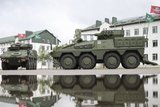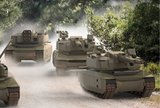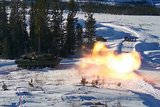Lockheed Martin, UK university team for AV protection
Lockheed Martin UK has partnered with research engineers at the University of Surrey to look into new lighter-weight methods of improving the protection and survivability of armoured vehicles. The focus of the research has been ceramic materials and how they can improve protection levels on vehicles such as those used in operational environments by the UK army and special forces.
According to the company, ceramic materials, which have increasingly been replacing steel in armour plating, to protect vehicles and their crews from the effects of attack, are extremely resistant to penetration by hostile weaponry while being less heavy than traditional armour plating.
The main challenge involved with the use of ceramics in this way has been the weakness of the adhesive bonding connecting ceramic plates to their backing, rendering the approach less robust than traditional metallic armour.
However, the latest work by scientists at the University of Surrey is the development of a method of treating the ceramic materials to improve the bond strength of both aluminia and silicon carbide ceramics to the composite backing. This greatly enhances the robustness of the protective armour to better meet operational needs in hostile environments.
Results have shown that using the technique on alumina and silicon carbide surfaces leads to increased bond strength. The tests revealed that when a 14.5mm armour piercing incendiary was fired at the panel it remained intact under a multi-hit environment.
Andrew Harris, Engineering Doctorate research engineer at the University of Surrey, explained: ‘Although ceramic armour has a great number of advantages over other protection methods, there are still some challenges. Our relationship with Lockheed Martin has enabled us to develop a method of treating the ceramic to considerably improve the effectiveness of ceramic armour plating. Key to achieving a step change in performance, proven in tests, has been the pre-conditioning of the ceramic surfaces, prior to bonding onto the support structure.’
Steve Burnage, head of design at LMUK’s Ampthill facility in Bedfordshire, added: ‘The reduction in weight of armoured vehicles is an increasingly important requirement for the army as it looks for the ability to more rapidly deploy an agile force into regions of conflict.’
More from Land Warfare
-
![Hungary set to begin using Hero 400 loitering munitions]()
Hungary set to begin using Hero 400 loitering munitions
Developed by Israel's Uvision and with systems being sold in the thousands to multiple European NATO countries and the US, the Hero family of loitering systems is also in production in the US and Italy, the latter through Rheinmetall.
-
![Croatia orders Leopards and CAESAR howitzers as Lithuania orders more CAESARs]()
Croatia orders Leopards and CAESAR howitzers as Lithuania orders more CAESARs
The Leopard is becoming the tank of choice in central and eastern Europe as Croatia joins Lithuania, the Czech Republic and Hungary in ordering the platform. Lithuania and Croatia have also signed for CAESAR howitzers.
-
![Light Reconnaissance Strike – enabling a vital mission set (Studio)]()
Light Reconnaissance Strike – enabling a vital mission set (Studio)
A new system-of-systems concept will unlock digital integration of sensors and weapons for Light Forces, allowing them to shape the battlefield environment on their own terms and upgrade legacy platforms.
























